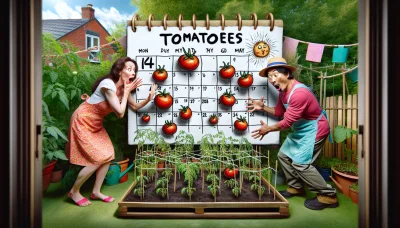How to eat a kiwi fruit Quiz
Test Your Knowledge
Question of
How to Eat a Kiwi Fruit: A Gardener's Guide
Kiwi fruits are not only delicious but also packed with a multitude of nutritional benefits that can significantly enhance a gardener's diet. Rich in vitamins C and K, fiber, and various antioxidants, kiwis can help in improving the immune system, aiding digestion, and reducing the risk of chronic diseases. For gardeners, who require ample energy and good health to maintain their gardens, incorporating kiwi fruits into their diet can provide the necessary nutrients to support their physically demanding activities. Additionally, the high vitamin C content in kiwis is essential for the repair and growth of tissues, making it a perfect snack for those who spend a lot of time nurturing their plants.
Selecting the Perfect Kiwi Fruit
Choosing ripe kiwi fruits, whether from your garden or the local market, can greatly enhance your eating experience. Look for kiwis that yield slightly to gentle pressure, similar to a ripe peach. The skin should be fuzzy but not wrinkled or bruised. If you're planning to eat them within a day, select kiwis that are very soft to the touch. For those looking to store kiwis for a bit longer, opt for firmer fruits, which will ripen over a few days at room temperature. A ripe kiwi should have a fragrant, sweet, and slightly tangy scent at the stem end. Avoid kiwis that are overly hard, have damp spots, or emit an off odor, as these are signs of under-ripeness or spoilage.
Preparation Methods for Kiwi Fruit
- Peeling: Gently remove the skin with a paring knife or a vegetable peeler.
- Slicing: Cut the kiwi into thin or thick slices, depending on your preference.
- Using in Recipes: Incorporate kiwi into salads, smoothies, desserts, and more for a refreshing flavor.
The Best Tools for Kiwi Fruit Preparation
When it comes to preparing kiwi fruits, having the right tools at your disposal can make all the difference. Ideally, a sharp knife and a good peeler are essential for efficiently handling these delicious fruits. Gardeners, in particular, might already have some of these tools in their toolkit. A sharp knife is crucial for slicing the kiwi into your desired size, while a peeler can help remove the skin smoothly without wasting any of the fruit. Some gardeners might also use specialized tools designed for other gardening tasks, which can be equally effective in the kitchen. The key is to use tools that allow for precision and minimal waste, ensuring you get the most out of your kiwi fruits.
Innovative Ways to Include Kiwi in Your Garden Diet
- Kiwi and Strawberry Salad - Combine fresh kiwi slices with strawberries, spinach, and a sprinkle of feta cheese for a refreshing salad. Drizzle with a light balsamic vinaigrette.
- Kiwi Salsa - Mix diced kiwi, tomatoes, onions, and jalapenos for a tangy twist on traditional salsa. Perfect for topping grilled fish or chicken.
- Kiwi Smoothie Bowls - Blend kiwis with bananas and a splash of almond milk to create a smooth base. Top with granola, coconut flakes, and more fresh kiwi slices.
- Kiwi Pavlova - Top a classic pavlova with whipped cream and a generous amount of fresh kiwi slices for a delightful dessert.
- Kiwi Chia Pudding - Layer chia pudding with kiwi puree for a healthy and visually appealing snack or breakfast option.
- Grilled Kiwi - Slice kiwis and grill them briefly on each side. Serve as a side dish or dessert topping with a drizzle of honey.
- Kiwi and Avocado Toast - Mash avocado on toast and top with sliced kiwi, a sprinkle of salt, and chili flakes for a quick and nutritious breakfast or snack.
- Kiwi Jam - Cook down kiwi with sugar and lemon juice to make a homemade jam that's perfect on toast or as a sweet addition to oatmeal.
Storing Your Kiwi Fruits
To maintain the freshness of your kiwi fruits, proper storage is key, both before and after they are cut. Before cutting, kiwi fruits should be kept at room temperature until they ripen. Once ripe, they can be moved to the refrigerator to slow down the ripening process and extend their freshness. If you prefer to speed up the ripening process, place the kiwi fruits in a paper bag along with an apple or banana; the ethylene gas produced by these fruits will help ripen the kiwis faster.
After cutting, kiwi fruits should be stored in the refrigerator to keep them fresh. Place the cut kiwi in an airtight container or wrap it tightly in plastic wrap to prevent it from absorbing other food odors and to minimize exposure to air, which can degrade its quality. Consuming cut kiwi fruits within a few days is recommended to enjoy their best taste and nutritional benefits.
Growing Your Own Kiwi Fruits
| Variety | Climate Preferences | Care Instructions | Harvest Time |
|---|---|---|---|
| Hayward | Mild temperate | Full sun, well-drained soil, regular watering | Late fall |
| Actinidia arguta (Hardy Kiwi) | Cold hardy | Partial to full sun, moist soil, protect from strong winds | Early fall |
| Golden Kiwi | Warm temperate | Full sun, well-drained soil, regular watering, needs high humidity | Mid to late fall |
| Saar Kiwi | Mild to cold climates | Full sun to partial shade, well-drained fertile soil, regular watering | Early to mid-fall |












